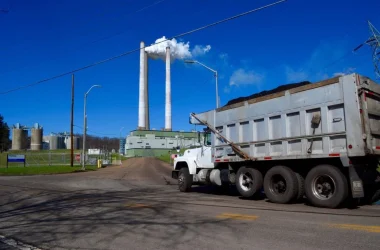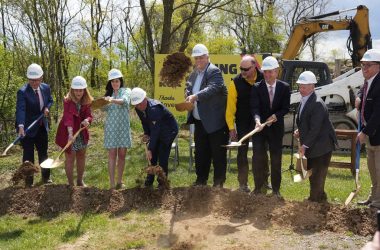By JESSICA FARRISH
The Register-Herald
MINDEN, W.Va. — A number of cancer patients from Minden who lived near a PCB dumping site are showing an “unusual” and aggressive form of lymphoma in a local study, an Oak Hill physician reported Wednesday.
Dr. Hassan Amjad said he’s also seeing higher than typically anticipated cases of multiple myeloma (MM), a rare form of bone marrow cancer, among Minden cancer patients.
Amjad said that “definitely more than 30 percent” of current residents have been diagnosed with a form of cancer, and 100 people who have lived or live in Minden have reported that one or more family members have been cancer patients.
Amjad is studying the link between PCB and what he and Minden residents say is a cancer cluster in the small community. Since May, Amjad has studied medical records and spoken with hundreds of cancer patients who live or have lived in Minden, a Fayette County town where Shaffer Mine and Johns Hopkins University dumped transformers laden with PCB oil at Shaffer’s mine site.
“We are seeing something very unusual,” Amjad said. “I think there is a new type of cancer, of lymphoma, that is due to PCB, but it needs further confirmation.
“We’re seeing a condition where the people have enlarged lymph nodes, and the doctors have not been able to make a diagnosis,” he said. “This has taken us off the main course, but we are going to find out more information.
“If we have enough cases, we may be able to determine that this is, possibly, a new disease.”
Cases of MM, a relatively rare form of bone marrow cancer, are much higher than average among Minden cancer patients who have submitted medical records, he added.
“We are seeing cases of myeloma and a lymphoma-like picture,” Amjad summarized the results of his study to date. “It’s an unusual form of lymphoma. Most of the people die very fast.”
EPA testing history
In 1984, the West Virginia Division of Natural Resources officials contacted the EPA to report PCB transformers at Shaffer Mine, located on land owned by Berwind Land Co.
EPA agents who tested the area discovered that samples taken from the old Shaffer site showed PCB levels of 250,000 parts per million (ppm). PCB transformers containing 50 ppm are considered hazardous under the Toxic Substances Control Act of 1976. EPA declared the site a “Superfund” site in December 1984.
After a failed $2 million EPA clean-up effort, EPA agents conducted a second clean-up effort by removing soil. At that time, EPA officials told Minden residents that the PCB levels did not present a health risk to their community, based on soil sample results.
The original cleanup was led by Robert Caron, an EPA agent. A federal court judge noted in 1994 that Caron had bungled the effort and lied about his academic record and expertise.
In 1992, EPA agents sealed the site, but residents are concerned that a 2001 flood and subsequent flooding spread PCB contamination to neighborhoods surrounding Shaffer.
Amjad asked Shaffer employees and their family members to contact him to share medical records for the study.
“My impression is (that) anybody who worked long enough on that place and was handling the PCBs, died of cancer,” he said.
He said that he is collecting information on Shaffer employees to broaden the study.
Patients may call 304-252-1600. Medical records may be mailed to 166 George Street, Beckley, WV 25801.
Individual reports
Amjad said residents of Rock Lick, located a few miles upstream from the Shaffer site, may have been impacted by environmental exposure to PCB. Medical records of a 50-year-old Rock Lick man report that he died in 2008 from various forms of cancer. Amjad said the man also displayed the lymphoma-like disease that Amjad has noted in Minden patients.
Nina Carson of Minden grew up and still lives in the only predominantly African-American neighborhood in Minden. She reported Tuesday that she wants EPA officials to test all of Minden and to offer personal testing for PCB exposure to all residents.
EPA agents are taking soil samples from only one site in Carson’s neighborhood, according to Headwaters Defense, a community action group.
“There are several people that have died of cancer here in the black community, and the whole thing, in a nutshell, is where Shaffer’s is,” Carson said. “We went down through Shaffer’s for years to get to the post office. People’s children played down through there.”
A crafter, Carson said she often picked flowers and looked for slate at Shaffer’s.
“We did that for years,” she said. “So I feel like everybody down here should be tested, because everybody went down through that mine a lot.”
EPA sampling
EPA officials told The Register-Herald Tuesday that its agents are sampling properties directly adjacent to Arbuckle Creek. The first sampling round will be on the Shaffer site and extend one mile along the creekbed.
“Additional sampling will occur if exceedances of the screening levels are seen in this round of sampling,” said Joan Schafer, EPA senior adviser for the Philadelphia office. “Arbuckle Creek is the main historic pathway for contamination to move from the site, prior to EPA’s removal actions.”
Schafer said EPA agents have gone door-to-door to identify parcels that “may not have returned access agreements and that should have received requests.”
She said the process is “stepwise in nature” and that agents will “continue to assess additional areas for potential contamination.”
Citizens may submit testing requests for potentially contaminated lots to Melissa Linden, 1650 Arch St., Mailcode 3HS32, Philadelphia, PA 19103.
See more from The Register-Herald




